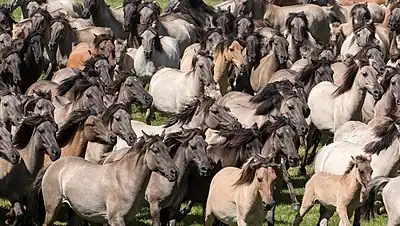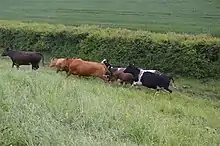Stampede
A stampede (/stæmˈpiːd/)[1] is a situation in which a group of large animals suddenly start running in the same direction, especially because they are excited or frightened. Non-human species associated with stampede behavior include horses, cattle, elephants, reindeer, sheep, pigs, goats, zebras, wildebeests, walruses,[2] and rhinoceroses.

Cattle stampedes

The animal behavior of stampeding was first noticed by cattle ranchers and cowboys in the American Wild West. Large herds of cattle would be managed across wide-open plains, with no fences to contain them. In these unbounded spaces, cattle were able to run freely, and sometimes the whole herd would take off in the same direction unexpectedly. Cowboys developed techniques to deal with this situation and calm the cattle, to stop the stampede and regain control of their herd.[3][4] The term "stampede" came from the Mexican Spanish term estampida ('an uproar').[5]
Cattle herds tended to be nervous, and any unusual occurrence, particularly a sudden or unexpected noise, could scare the cattle and kick off a stampede. Things such as a gunshot, a lightning strike, a clap of thunder, someone jumping off a horse, a horse shaking itself, or even a tumbleweed being blown into the herd have been known to cause stampedes.[6][3][4]
One method used for stopping a stampede is to turn the moving herd into itself so that it runs in wide circles, rather than running off a cliff or into a river. The circle can be made smaller and smaller, eventually forcing the herd to slow down due to lack of space in which to run. Tactics used to make the herd turn into itself include firing a pistol, which creates noise to make the leaders of the stampede turn.[3][4][6][7]
Animals who stampede, especially cattle, are less likely to do so after having eaten and watered, and if they are spread out in smaller groups to digest.[6][7] To further reduce the risk of stampedes, cowboys sometimes sing or whistle to calm the herds disquieted by nightfall.[3] Those on watch at night avoid doing things which could startle the herd and even distance themselves before dismounting a horse or lighting a match.[8]
Sometimes humans purposefully induce cattle to stampede as a component of warfare or hunting, such as some Native Americans, who were known to provoke American bison herds to stampede off a buffalo jump for hunting purposes, and harvest the animals after they are killed or incapacitated by the fall.
Human stampedes and crushes
If you look at the analysis, I've not seen any instances of the cause of mass fatalities being a stampede. People don't die because they panic. They panic because they are dying.
Keith Still, professor of crowd science at Manchester Metropolitan University[9]
... far from mass panic occurring, being in an emergency can create a common identity among those affected. A consequence of this is that people are cooperative and altruistic towards others – even when among strangers, and/or in life–threatening situations.[10]
Cocking, Drury and Reicher
A human stampede is an event that can occur in dangerously large or dense crowds of people, and can result in a large number of fatalities or other casualties of crowd-goers. Stampedes typically occur when a large group of people all try to get away from a perceived danger.[11][12] The phenomenon is similar to crowd collapses and crushes in both the conditions in which they begin (dangerous levels of crowding) and in the number and severity of casualties that can occur.[13] However, there has been little research conducted into what happens during a human stampede, or what exactly causes them to start.[14] As a result, the terminology of stampedes, crushes, and collapses is not well-defined.
While media and popular culture depictions tend to exaggerate dangers associated with stampedes, and popular news reports of such instances often mention "panic," actual instances of mass panic are rare,[15] and panic itself is rarely the cause of fatalities in such events.[16] In a stampede, the difference in speed between the front of a crowd and the back can cause people to fall over each other and pile up, causing asphyxiation.[13] Trampling is rarely the cause of fatal injuries in stampede conditions, unless egress is impeded.[9]
Stampede is not only an incorrect term, it is a loaded word, as it assigns blame to the victims for behaving in an irrational, self-destructive, unthinking and uncaring manner, it's pure ignorance, and laziness [...] It gives the impression that it was a mindless crowd only caring about themselves, and they were prepared to crush people.
In virtually all these situations, this is not the case, and it is usually the authorities to blame for poor planning, poor design, poor control, poor policing and mismanagement.
The truth is that people are only directly crushed by others who have no choice in the matter, and the people who can choose don't know what is going on because they're too far away from the epicentre.
Reports of human stampedes have become more common in modern times,[14] growing more than fourfold since 1990. They can occur during religious festivals and large entertainment events, such as concerts or sporting events.[16]
In popular culture
- Kimba The White Lion (1965): In episode 39 Running Wild, a stampede of antelopes is the main problem for the protagonists to solve.
- The Lion King (1994) and its 2019 remake both include a stampede of wildebeests.
See also
References
- stampede 1 (noun). Retrieved 16 June 2021.
{{cite encyclopedia}}:|website=ignored (help) - "3,000 walruses die in stampede tied to climate". NBC News. Associated Press. 14 December 2007. Retrieved 4 September 2016.
- "Cowboys and Cattle Drives" (PDF). The Core Knowledge Foundation. Retrieved 16 May 2023.
- "The Cattle Drive and Westward Expansion". National Agriculture in the Classroom. Retrieved 16 May 2023.
- "stampede". Online Etymology Dictionary. Retrieved 16 May 2023.
- Fay E. Ward, The cowboy at work, Courier Dover Publications, 2003, ISBN 0-486-42699-8 p. 28
- Welch, Bob (2015-03-05). "Cowboy Up: Stop a stampede". American Cowboy. Retrieved 2023-05-16.
- Fay E. Ward, The cowboy at work, Courier Dover Publications, 2003, ISBN 0-486-42699-8 p. 31
- Benedictus, Leo (3 October 2015). "Hajj crush: how crowd disasters happen, and how they can be avoided". The Guardian. Archived from the original on 2 July 2019. Retrieved 4 October 2015.
- Cocking, Christopher; Drury, John; Reicher, Steve (November 2012). "The psychology of crowd behaviour in emergency evacuations: Results from two interview studies and implications for the Fire and Rescue Services". Irish Journal of Psychology. 30 (1): 59–73. doi:10.1080/03033910.2009.10446298.
- Syed, Armani. "Why Crowd Crushes Like South Korea's Halloween Surge Are So Deadly". Time. Retrieved 17 May 2023.
- "Updated - Paceville crush: Man arrested for letting off gas spray; heated exchanges in Parliament; dramatic video". Times of Malta. 16 November 2015.
- Sreenivas, Shishira. "Stampede: What to Know". WebMD. Retrieved 17 May 2023.
- Feltman, Rachel. "HOW HUMAN STAMPEDES, LIKE THE ONE NEAR MECCA, TURN DEADLY". The Washington Post. Retrieved 17 May 2023.
- Ro, Christine (21 March 2018). "The secret science that rules crowds". BBC Future. Retrieved 14 August 2018.
- Seabrook, John. "Crush Point: When large crowds assemble, is there a way to keep them safe?". The New Yorker. Retrieved 17 May 2023.
- Lock, Samantha (1 November 2022). "Crowd crushes: how disasters like Itaewon happen, how can they be prevented, and the 'stampede' myth". The Guardian.